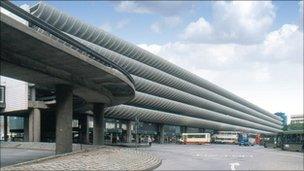Preston bus station on UK monument 'at risk' list
- Published

Preston Bus Station may be demolished as part of a redevelopment scheme in the city
Preston Bus Station has been listed as one of the world's "most treasured locations".
The "brutalist" style building, earmarked for demolition, is one of seven monuments being placed on an "at risk" list by the World Monuments Fund (WMF).
Its 2012 World Monuments Watch list also includes The Hayward Gallery and Coventry Cathedral.
These latest entries mean the UK now has 30 sites on the WMF's list.
Others include Birmingham Central Library, Quarr Abbey on the Isle of Wight and the South Atlantic island of Saint Helena.
Launched in 1996, the list of monuments at risk is issued every two years and has identified 67 monuments from around the world in its latest report.
The WMF has included 688 sites in 132 countries and territories on its nine watch lists so far.
The WMF says its list "seeks to draw international attention as well as local community support for some of the world's most treasured locations".
It also says that a monument or building's inclusion on its watch list can be crucial in raising awareness and funds for its preservation.
Historic structures
Coventry Cathedral - the only English cathedral to be destroyed as an act of war - was gutted by incendiary bombs during World War II. A new cathedral was built, but the ruins were also preserved.
The WMF says that "exposure to the elements over time has eroded the ruins, and significant water infiltration problems and structural deterioration require immediate action".
Newstead Abbey is best known as the ancestral home of Lord Byron, but the watch list says it has "suffered significant deterioration, and a strategy for its conservation and long-term maintenance is greatly needed".
It also adds that the building's "restoration... would benefit the local community".
The watch list has included three buildings - the Hayward Gallery, Birmingham City Library and Preston Bus Station - under the heading of British Brutalism.
Preston Bus Station - once the largest bus station in the world - is scheduled to be pulled down as part of a redevelopment plan for the city centre.
Birmingham Central Library, the largest non-national library in Europe, is also threatened with demolition for redevelopment purposes.
The buildings were all were designed "in what is commonly referred to as the brutalist style... characterised by bold geometries, the exposure of structural materials, and functional spatial design", says the report..
'Cultural inheritance'
The Hayward Gallery at the Southbank Centre was, according to the WMF, once deemed "a visionary combination of performance spaces and an art gallery, but it continues to be denied heritage status".
The ancient, now-ruined Cistercian Abbey of St Mary's at Quarr was founded in 1132 on the Isle of Wight. The watch list says that these medieval ruins are in need of repair, as are the monastic buildings and surrounding infrastructure.
The report also lists the South Atlantic island of Saint Helena, once home to the French Emperor Napoleon in exile.
The WMF notes the island "is not eligible for most conservation funding available in the United Kingdom, even though it is a British Territory".
The watch list adds: "If more resources were made available to the island, the conserved built heritage could be used to bolster the economy through tourism development, especially after the construction of a planned airport."
WMF chief executive Jonathan Foyle said: "For a decade and a half, the Watch has reminded us that no country is immune to man-made and natural disasters, and the casual degradations of its built environment.
"We can never afford to take for granted our irreplaceable and enriching cultural inheritance, but in an age of greater austerity this Watch further reminds to be vigilant, look after and enjoy historic places, many of which we could not afford to build today."

- Published20 September 2011